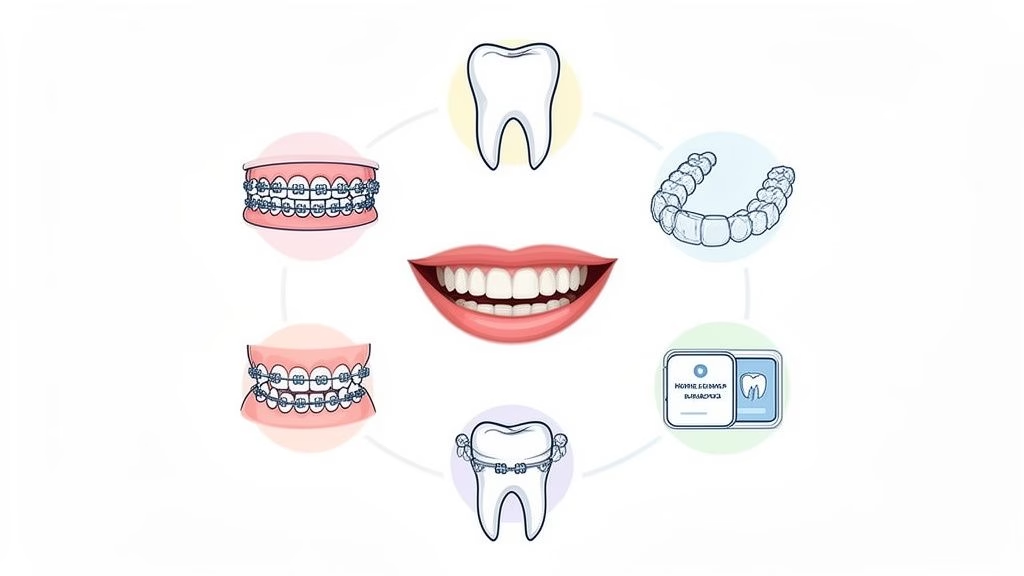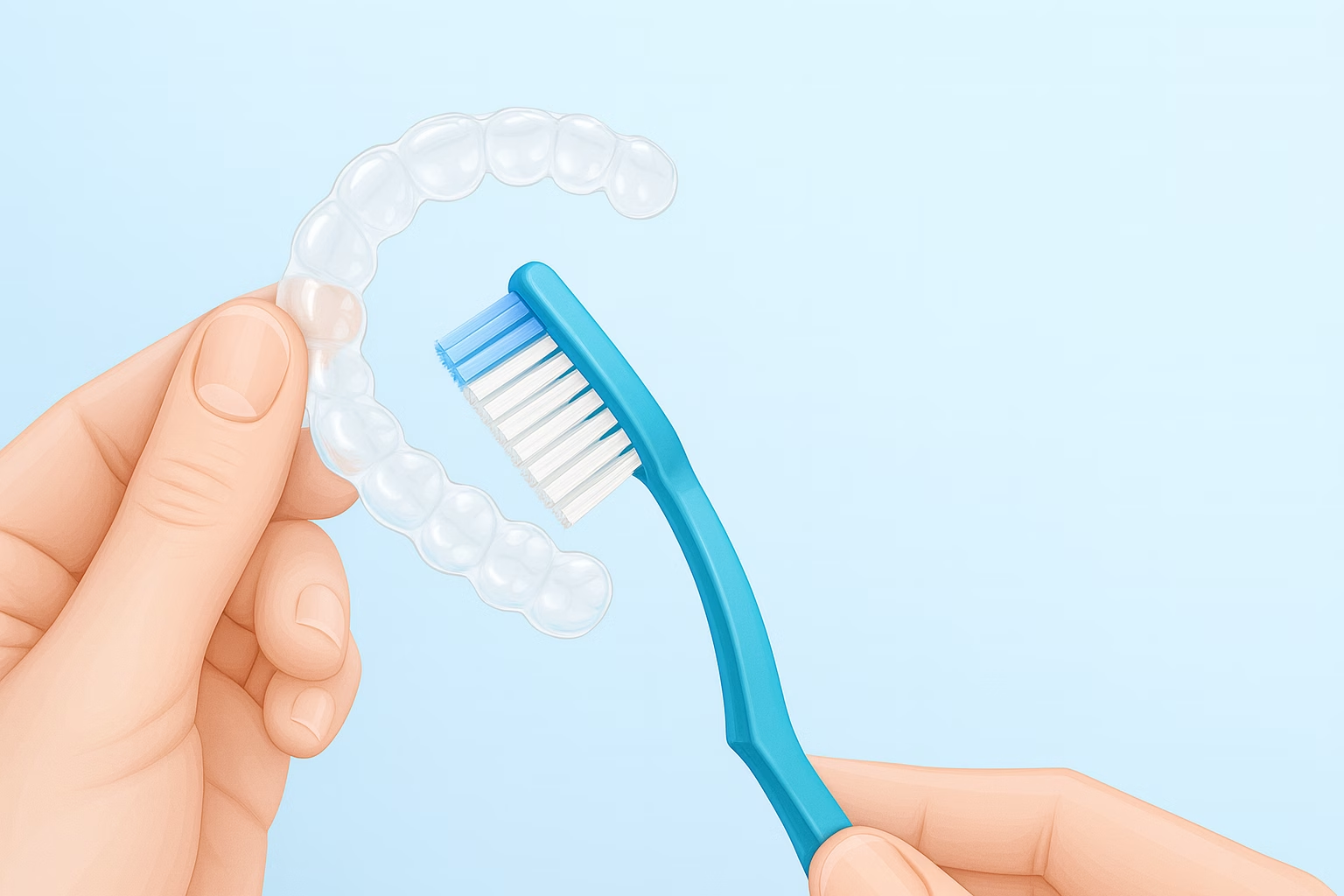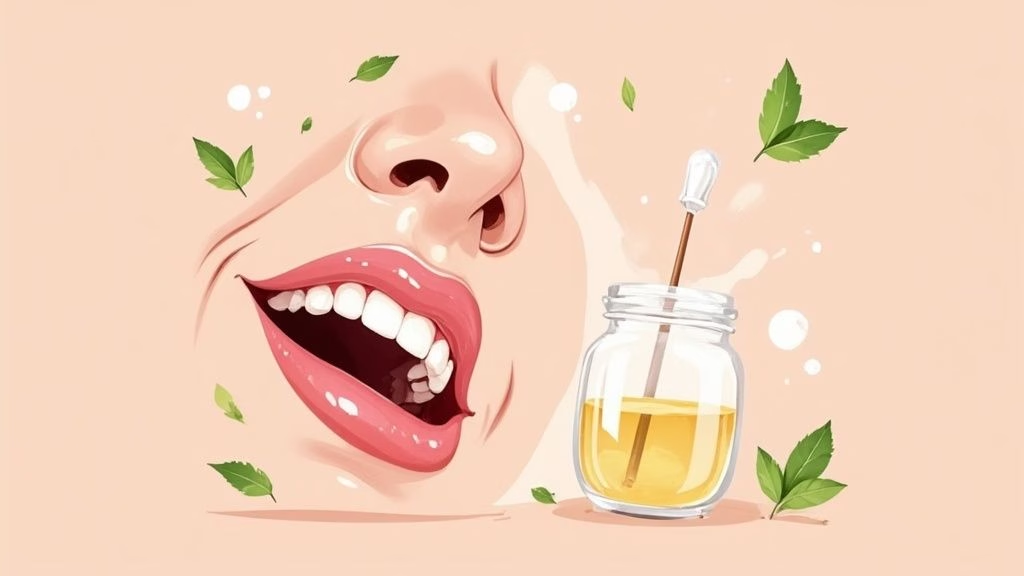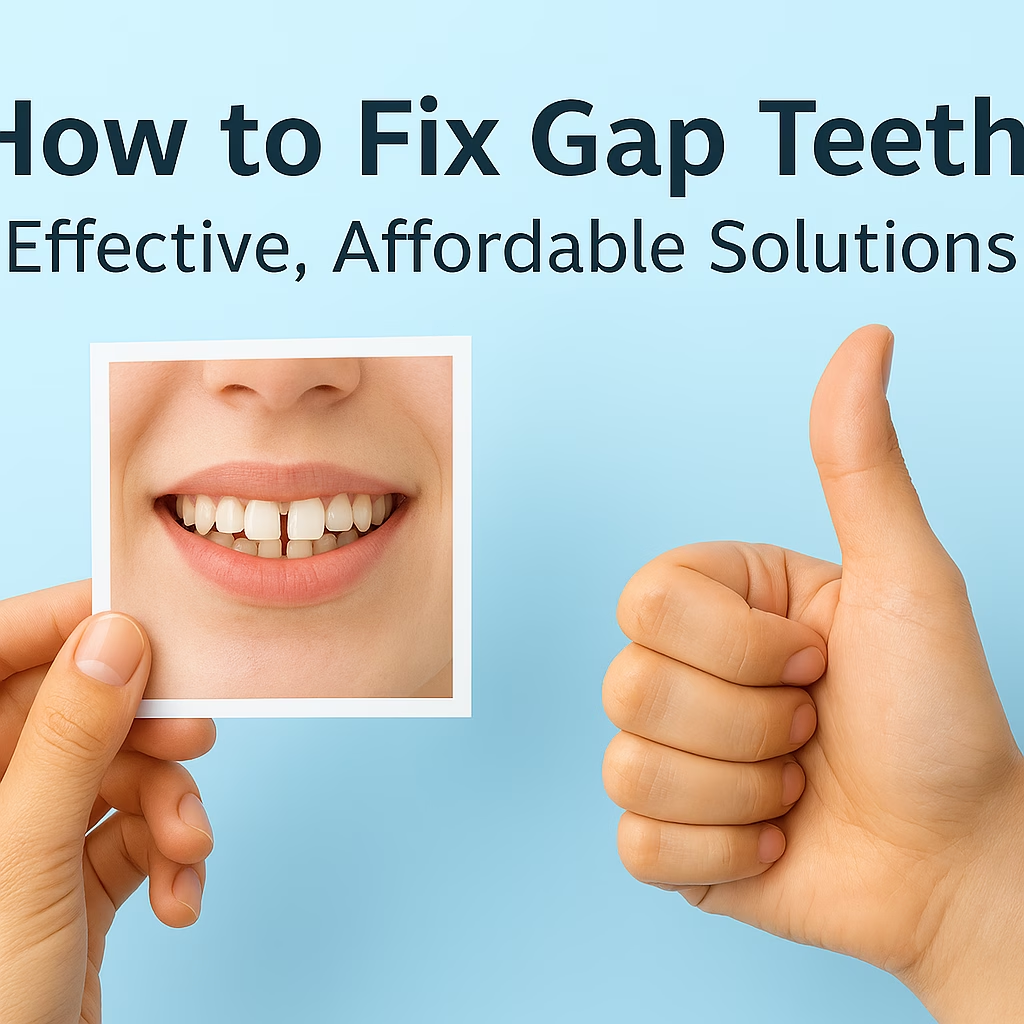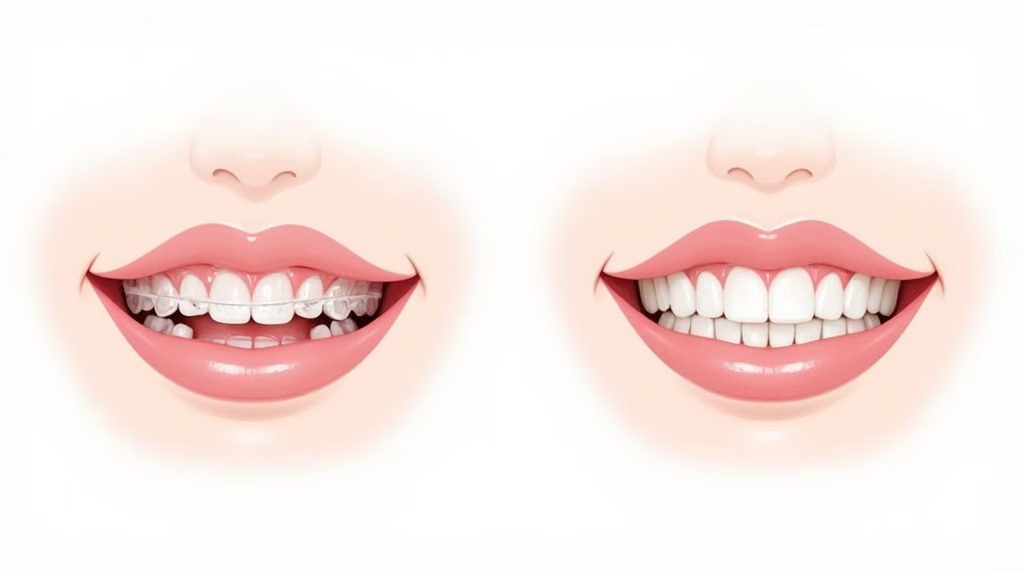What Causes Crooked Teeth and How to Fix Them
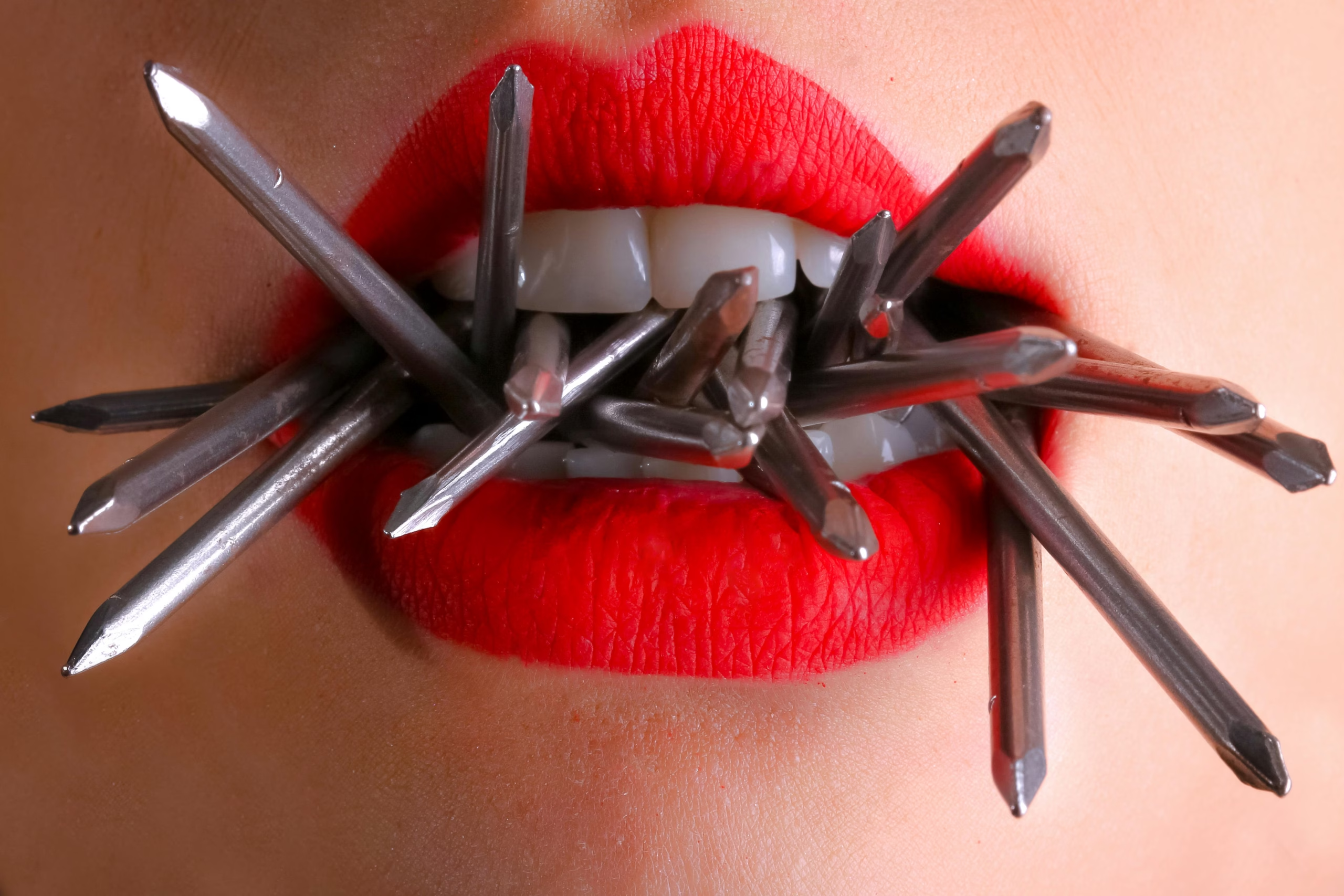
So, what actually causes crooked teeth? The simple answer is that it’s rarely down to just one culprit. More often than not, it’s a unique combination of your family genetics, certain childhood habits, and sometimes other oral health issues that all have a say in how your teeth line up.
The Blueprint Behind Your Smile
Ever looked in the mirror and wondered why your smile is the way it is? A big part of that story was written before you were even born. Think of it like a puzzle: for a straight smile, your jaw size and tooth size need to fit together just right.
If you inherit a small jaw from one parent but larger teeth from another, you run into a classic overcrowding problem. There just isn’t enough space for everything to fit neatly, so teeth get pushed, twisted, and overlapped.
Of course, the opposite can happen too. A larger jaw combined with smaller teeth often leaves noticeable gaps. These aren’t just quirks; they’re very often hereditary traits passed down through your family tree.
The real drivers behind crooked teeth are usually a blend of what you’re born with and the habits you pick up along the way. Getting to grips with these root causes is the first real step toward achieving a healthier, straighter smile.
To help you see the bigger picture, here’s a quick look at the main factors we’ll be exploring.
Primary Causes of Crooked Teeth at a Glance
| Cause Category | How It Affects Your Smile |
|---|---|
| Genetics | You might inherit a small jaw or large teeth, leading to crowding or gaps. |
| Early Habits | Things like thumb sucking or dummy use can physically move teeth and alter jaw growth. |
| Poor Oral Health | Losing baby teeth too early can cause adult teeth to drift into the wrong positions. |
| Other Factors | Injuries to the face or mouth can shift teeth out of alignment. |
This table gives a bird’s-eye view, but each of these factors has its own story. Let’s dive a bit deeper into what’s really going on.
The infographic below brings these core factors to life, showing how genetics, habits, and your dental health are all connected.
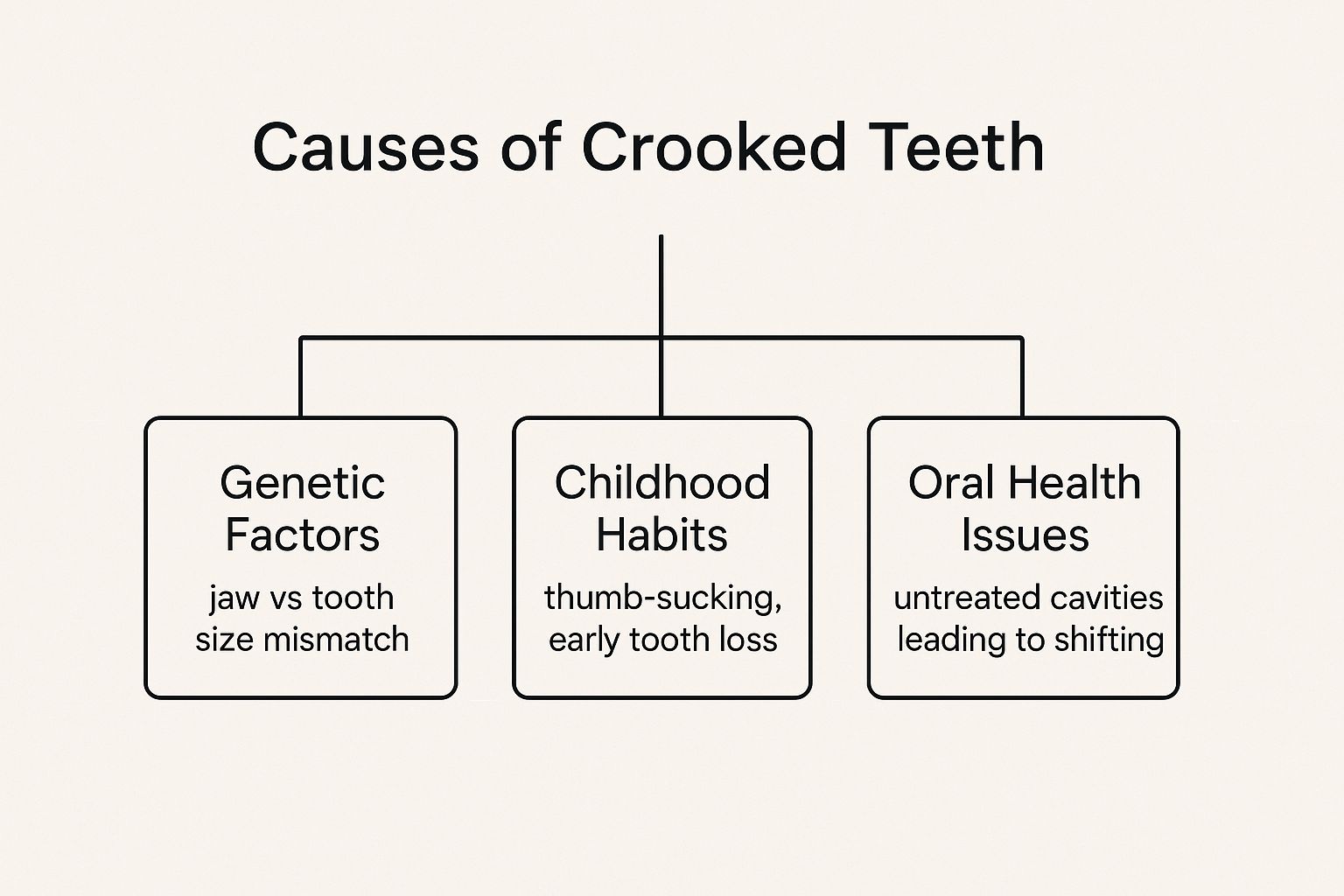
As you can see, a mismatch between your jaw and tooth size is a fundamental genetic starting point. From there, early habits and health problems can either make things worse or create new alignment issues entirely.
The good news? Understanding why your teeth are crooked is the first step in figuring out how to fix them. And thankfully, modern solutions like Toothfairy offer a smarter, more affordable way to correct these issues, no matter where they came from.
The Role Genetics Plays in Your Smile
Ever wondered if you were just destined to have crooked teeth? Well, you might not be far off. Your genetic makeup often lays the groundwork for your smile long before your first adult tooth ever pushes through.
It helps to think of it like this: your jaw is the room, and your teeth are the furniture. If you inherit a small jaw from one parent but large teeth from another, there simply isn’t going to be enough space. The inevitable result? Crowding and misaligned teeth.
This genetic mismatch is one of the most common reasons for alignment problems. The reverse is also true—a large jaw paired with smaller teeth often leads to noticeable gaps. These traits tend to run in families, which is why if your parents needed braces, there’s a fair chance you will too.
In the UK, this isn’t a rare problem. Crooked teeth affect roughly 30-35% of the population to the point where orthodontic treatment is needed. This genetic lottery, where the size of your jaw and teeth don’t quite match up, is a huge contributor. It’s also behind more specific issues like overbites and underbites. For a deeper look, you can explore more data on adult oral health from the UK government.
Inherited Bite and Alignment Issues
Beyond just crowding or gaps, your DNA can also dictate more complex alignment problems. These usually come down to how your upper and lower jaws relate to each other—what dentists call your “bite”.
Some of the most common hereditary bite issues include:
- Overbite: This is when your upper front teeth stick out too far over your lower teeth.
- Underbite: The opposite scenario, where your lower teeth jut out in front of your upper teeth.
- Crossbite: A misalignment where some of your upper teeth actually sit inside your lower teeth when you bite down.
These aren’t just minor quirks; they’re structural traits hardwired by your genes. It means that even with perfect brushing and flossing, your teeth might be predisposed to growing in crooked simply because of the jaw structure you were born with.
Since these issues are passed down through generations, they can’t be avoided with good habits alone. This is exactly why orthodontic treatment is so often necessary. Thankfully, modern and affordable solutions, like those from Toothfairy, provide a way to correct the smile genetics gave you, helping you achieve a healthier, straighter smile without breaking the bank.
How Childhood Habits Can Shape Your Teeth
It’s not just genetics that call the shots when it comes to straight teeth. The habits we pick up in our early years can have a massive impact on how our jaw and teeth develop. These seemingly harmless actions can apply a surprising amount of pressure, gradually nudging teeth out of place over time.
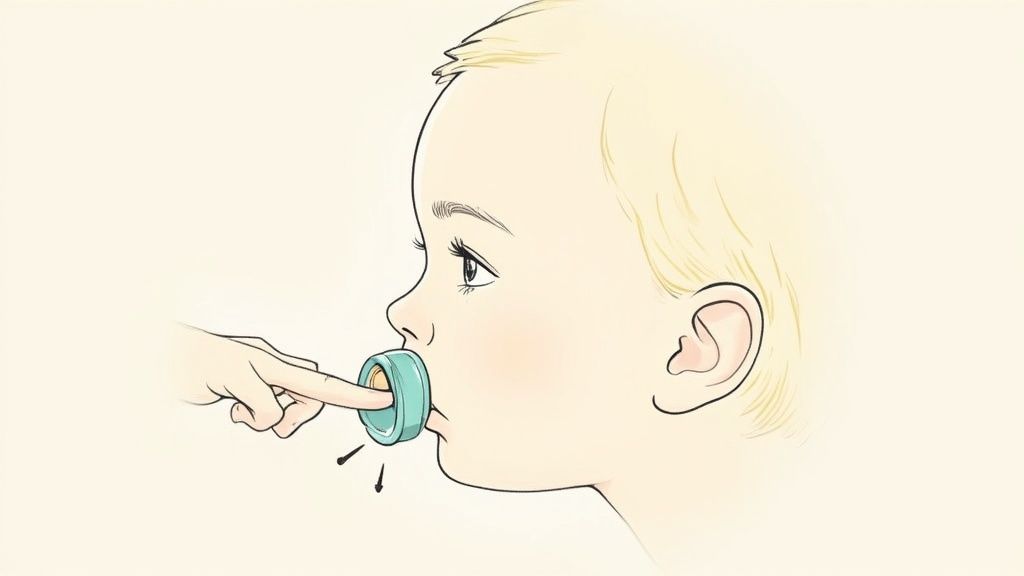
Imagine a young sapling in a garden. If a gentle but constant breeze pushes against it day after day, that sapling will eventually start to grow on a slant. It’s the same principle with a child’s teeth. Persistent pressure from things like thumb-sucking or using a dummy can physically shift developing teeth from their ideal positions.
This steady force doesn’t just stop at the teeth. It can also subtly reshape the palate (the roof of the mouth) and influence how the jaw itself grows. This is why most dental professionals suggest it’s best to help children move on from these habits by the time they’re around three years old.
Common Habits That Misalign Teeth
The link between these early behaviours and later dental issues is very clear. A few of the most common culprits are:
- Prolonged Dummy Use: Continuing with a dummy or pacifier well into the toddler years is a leading cause of an “open bite,” where the front teeth don’t overlap when the mouth is closed.
- Thumb-Sucking: Very similar to dummy use, this habit applies forward pressure that can cause the top front teeth to stick out.
- Tongue Thrusting: This is an incorrect swallowing pattern. Instead of the tongue resting on the roof of the mouth, it pushes forward against the front teeth, slowly forcing them out of line.
- Mouth Breathing: Usually a result of blocked nasal passages from allergies or large tonsils, chronic mouth breathing can alter facial development. It often leads to a narrower upper jaw, which means there isn’t enough space for the adult teeth, causing crowding.
It’s also vital to remember that baby teeth are more than just practice teeth; they’re essential placeholders for the adult set. If a baby tooth is lost too early, whether through decay or an accident, it triggers a chain reaction. The teeth on either side can start to drift into the gap, blocking the way for the permanent tooth waiting to come through.
When this happens, the adult tooth has no choice but to erupt at an angle, crooked, or it might even get stuck in the jaw, becoming what we call an “impacted” tooth.
Spotting these habits early can make a huge difference. But if the alignment has already been affected, don’t worry—it’s never too late to find a solution. With modern, affordable options from providers like Toothfairy, you can correct issues caused by childhood habits without the hefty price tag of some well-known aligner brands.
The Hidden Link Between Oral Health and Alignment
It’s tempting to see crooked teeth as a purely cosmetic issue, something separate from the “health” of your mouth. But in reality, the two are often deeply intertwined. Neglecting your dental hygiene can kick off a domino effect that ends up scrambling the alignment of your smile.
Think about it: if problems like tooth decay or gum disease are left to their own devices, they can lead to the worst-case scenario—losing a tooth.
Once a tooth is gone, the whole dynamic in your mouth changes. The neighbouring teeth naturally start to drift and tilt into the gap, trying to fill the empty space. This slow, steady movement can throw the entire dental arch out of whack, turning a once-straight smile into a crooked one over time.
This shifting isn’t just about looks, either. It creates a cascade of other problems, like new gaps, overcrowding in other spots, and a bite that doesn’t quite line up, which can affect how you chew. A single lost tooth really can set off a chain reaction that impacts your entire mouth.
Your First Line of Defence
This is why looking after your oral health is about so much more than just preventing cavities. It’s one of the best things you can do to keep your smile straight and healthy for the long haul. When your teeth and gums are in great shape, you’re keeping the very foundation of your smile strong and stable.
While oral health in the UK has come on in leaps and bounds, crooked teeth are still a common worry. Back in the 1970s, around a third of Brits had no natural teeth at all, a figure that’s thankfully dropped to just 6% today. But even with fewer people losing teeth, alignment issues are still widespread. You can read more about these fascinating dental health trends and their impact.
It helps to picture your teeth as a tightly packed row of books on a shelf. If you pull one out, what happens? The others start to lean and slide into the empty space. Your smile works the same way—each tooth helps hold its neighbours in place.
So, that simple daily routine of brushing and flossing is one of your most powerful tools against developing crooked teeth later in life. But if shifting has already happened, don’t worry—modern, affordable treatments can help. With Toothfairy, you can fix alignment issues caused by tooth loss without the hefty price tag of some big-name aligner brands, putting a straight smile back within reach.
Finding Modern Solutions for Crooked Teeth
Knowing what causes crooked teeth is one thing, but figuring out how to fix them is the next logical step. While traditional metal braces certainly still have their place, modern orthodontics has opened up a world of far more discreet and convenient ways to get a straighter, healthier smile.
Clear aligners, especially, have completely changed the game. These are essentially transparent, removable trays that guide your teeth into place without the obvious look of metal brackets and wires. It’s no wonder they’ve become such a popular choice for adults and teens.
This is where a service like Toothfairy really shines. By using advanced tech to map out a precise, personalised treatment plan, we make that smile you’ve always wanted more affordable and accessible than some other costly aligner brands. Toothfairy provides a smarter approach to teeth straightening, cosmetic work, and even dental emergencies.
Choosing Your Treatment Path
The journey to a straighter smile isn’t a one-size-fits-all experience anymore. Today’s options are designed to fit into your life, not disrupt it.
Of course, when you’re looking at modern solutions, picking a dental professional you can trust is absolutely key. It’s even worth looking into their online presence to get a feel for them, a point explored in an article on why online reputation management is essential for dental practices.
So, what makes modern aligner treatments so appealing?
- Discretion: The aligners are nearly invisible, so most people won’t even know you’re straightening your teeth.
- Convenience: You can pop them out to eat, drink, and clean your teeth, which means you don’t have to give up your favourite foods.
- Comfort: Because they’re made from smooth plastic, they are generally much more comfortable than traditional braces and won’t irritate your cheeks or gums.
Modern orthodontics has put the power back in your hands. With accessible and affordable solutions, you can correct alignment issues caused by genetics, habits, or oral health history without putting your life on hold.
At the end of the day, whether you have a bit of minor crowding or more noticeable gaps, there’s a modern solution that can work for you. With Toothfairy, you get the peace of mind of a dentist-prescribed plan, making a confident, straight smile a realistic goal for just about anyone.
Frequently Asked Questions
Once you understand what causes crooked teeth, it’s natural to have a few more questions pop into your head. Here are some straightforward answers to the most common queries we hear.
Can Crooked Teeth Straighten Out on Their Own?
In a word, no. Unfortunately, crooked teeth don’t have a way of correcting themselves. In fact, the opposite is often true; issues like crowding can actually get worse as we age and our teeth naturally drift forward.
The only way to guide teeth into their correct alignment is with orthodontic treatment. This involves applying gentle, consistent pressure over time to move them into the right place for a healthy, lasting smile.
Is Straightening Crooked Teeth Just for Cosmetic Reasons?
While a straight smile is a fantastic confidence booster, the benefits run much deeper than just appearances. Misaligned teeth create nooks and crannies that are difficult to clean, raising your risk of cavities and gum disease.
Beyond that, a poor bite can lead to jaw pain, chronic headaches, and uneven wear and tear on your tooth enamel. Think of straightening your teeth as a crucial investment in your long-term oral health. For anyone tasked with explaining these concepts, having access to effective patient education resources can make a world of difference.
Are Clear Aligners as Good as Traditional Braces?
For most common alignment problems—like crowding, gaps, and many bite issues—clear aligners are an excellent and highly effective choice. Modern systems, such as those from Toothfairy, use precise 3D imaging to create a treatment plan mapped out specifically for your smile.
They also come with some serious lifestyle perks. You can take them out to eat and clean your teeth, which is much simpler than navigating around fixed brackets. Plus, they’re nearly invisible. This convenience and discretion make them a popular and often more affordable choice for adults, especially compared to a specific aligner brand you may have heard of.
How Long Does It Take to Fix Crooked Teeth?
This really depends on your individual situation. Some minor adjustments can be completed in as little as six months, but more complex cases might take anywhere from 12 to 18 months, or sometimes longer.
The main thing to remember is that modern treatments are designed to be as efficient as possible. A consultation will give you a clear, personalised timeline, but the goal is always to get you to your ideal smile safely and effectively.
A proper assessment is always the first step. It’s the only way to know exactly what your smile needs and how long it will take to achieve.
Ready to take the next step towards a healthier, straighter smile? With Toothfairy, you can start your journey with a convenient, dentist-led plan that fits your life and budget. Find out how our smarter clear aligner solutions can work for you.
Last updated on October 21, 2025

Toothfairy Care Team
Toothfairy, is the world's smartest dental app, that connects patients to a dentist for a range of issues, from emergencies, cosmetics, prescriptions to virtual exams.
Toothfairy Care Team
Toothfairy, is the world's smartest dental app, that connects patients to a dentist for a range of issues, from emergencies, cosmetics, prescriptions to virtual exams.
